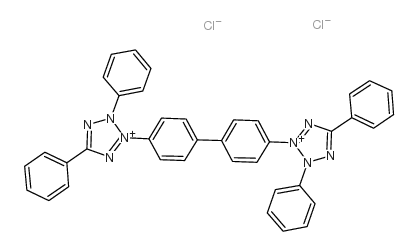298-95-3
| 中文名 | 氯化新四唑 |
|---|---|
| 英文名 | Neotetrazolium chloride |
| 中文别名 |
3,3'-(4,4'-联苯撑)双(2,5-联苯-2H-四氯化唑)
新四氮唑 |
| 英文别名 |
NTC
6-nitrobenzylalcohol NEOT TETRAZOLIUM PURPLE TETRAZOLE PURPLE NTMF NEOTETRAZOLIUM BLUE neotetrazolium |
| 密度 | 1.0962 (rough estimate) |
|---|---|
| 沸点 | 754.15°C (rough estimate) |
| 熔点 | 230ºC (dec.)(lit.) |
| 分子式 | C38H28Cl2N8 |
| 分子量 | 667.58900 |
| 精确质量 | 666.18100 |
| PSA | 69.18000 |
| LogP | 0.41040 |
| 外观性状 | 赭色-黄色至黄色-棕色粉末 |
| 折射率 | 1.6300 (estimate) |
| 储存条件 | 一、贮存 2-8°储存。 |
| 水溶解性 | methanol: 50 mg/mL, clear |
| 计算化学 | 1.疏水参数计算参考值(XlogP):无 2.氢键供体数量:0 3.氢键受体数量:4 4.可旋转化学键数量:7 5.互变异构体数量:无 6.拓扑分子极性表面积51.2 7.重原子数量:48 8.表面电荷:2 9.复杂度:836 10.同位素原子数量:0 11.确定原子立构中心数量:0 12.不确定原子立构中心数量:0 13.确定化学键立构中心数量:0 14.不确定化学键立构中心数量:0 15.共价键单元数量:3 |
| 更多 | 一、物性数据 性状:不可用 密度(g/mL,25/4℃):不可用 相对蒸汽密度(g/mL,空气=1):不可用 熔点(ºC):230 沸点(ºC,常压):不可用 沸点(ºC,5.2kPa):不可用 折射率:不可用 闪点(ºC):不可用 比旋光度(º):不可用 自燃点或引燃温度(ºC):不可用 蒸气压(kPa,25ºC):不可用 饱和蒸气压(kPa,60ºC):不可用 燃烧热(KJ/mol):不可用 临界温度(ºC):不可用 临界压力(KPa):不可用 油水(辛醇/水)分配系数的对数值:不可用 爆炸上限(%,V/V):不可用 爆炸下限(%,V/V):不可用 溶解性:溶于甲醇 |
Synonym:Neotetrazolium chloride Section 2 - COMPOSITION, INFORMATION ON INGREDIENTS
Risk Phrases: None Listed. Section 3 - HAZARDS IDENTIFICATION EMERGENCY OVERVIEW
Light sensitive.The toxicological properties of this material have not been fully investigated. Potential Health Effects Eye: Causes eye irritation. Skin: Causes skin irritation. May be harmful if absorbed through the skin. No data found on whether or not this chemical would be likely to cause an allergic skin reaction. Ingestion: May cause irritation of the digestive tract. The toxicological properties of this substance have not been fully investigated. May be harmful if swallowed. Inhalation: Causes respiratory tract irritation. The toxicological properties of this substance have not been fully investigated. May be harmful if inhaled. Chronic: No information found. Section 4 - FIRST AID MEASURES Eyes: Immediately flush eyes with plenty of water for at least 15 minutes, occasionally lifting the upper and lower eyelids. Get medical aid. Skin: Get medical aid. Flush skin with plenty of water for at least 15 minutes while removing contaminated clothing and shoes. Ingestion: Get medical aid. Do NOT induce vomiting. If conscious and alert, rinse mouth and drink 2-4 cupfuls of milk or water. Inhalation: Remove from exposure and move to fresh air immediately. Get medical aid. Notes to Physician: Treat symptomatically and supportively. Section 5 - FIRE FIGHTING MEASURES General Information: As in any fire, wear a self-contained breathing apparatus in pressure-demand, MSHA/NIOSH (approved or equivalent), and full protective gear. During a fire, irritating and highly toxic gases may be generated by thermal decomposition or combustion. Extinguishing Media: In case of fire, use water, dry chemical, chemical foam, or alcohol-resistant foam. Section 6 - ACCIDENTAL RELEASE MEASURES General Information: Use proper personal protective equipment as indicated in Section 8. Spills/Leaks: Vacuum or sweep up material and place into a suitable disposal container. Clean up spills immediately, observing precautions in the Protective Equipment section. Avoid generating dusty conditions. Provide ventilation. Section 7 - HANDLING and STORAGE Handling: Wash thoroughly after handling. Remove contaminated clothing and wash before reuse. Use with adequate ventilation. Minimize dust generation and accumulation. Avoid contact with eyes, skin, and clothing. Avoid breathing dust. Storage: Store in a cool, dry place. Keep container closed when not in use. Store protected from light. Section 8 - EXPOSURE CONTROLS, PERSONAL PROTECTION Engineering Controls: Facilities storing or utilizing this material should be equipped with an eyewash facility and a safety shower. Use adequate general or local exhaust ventilation to keep airborne concentrations below the permissible exposure limits. Exposure Limits CAS# 298-95-3: Personal Protective Equipment Eyes: Wear appropriate protective eyeglasses or chemical safety goggles as described by OSHA's eye and face protection regulations in 29 CFR 1910.133 or European Standard EN166. Skin: Wear appropriate gloves to prevent skin exposure. Clothing: Wear appropriate protective clothing to minimize contact with skin. Respirators: Follow the OSHA respirator regulations found in 29 CFR 1910.134 or European Standard EN 149. Use a NIOSH/MSHA or European Standard EN 149 approved respirator if exposure limits are exceeded or if irritation or other symptoms are experienced. Section 9 - PHYSICAL AND CHEMICAL PROPERTIES Physical State: Powder Color: beige to brown Odor: None reported. pH: Not available. Vapor Pressure: Not available. Viscosity: Not available. Boiling Point: Not available. Freezing/Melting Point: 230 deg C (dec) Autoignition Temperature: Not applicable. Flash Point: Not applicable. Explosion Limits, lower: Not available. Explosion Limits, upper: Not available. Decomposition Temperature: 230 deg C Solubility in water: Specific Gravity/Density: Molecular Formula: C38H28Cl2N8 Molecular Weight: 667.59 Section 10 - STABILITY AND REACTIVITY Chemical Stability: Stable under normal temperatures and pressures. May discolor on exposure to light. Conditions to Avoid: Light, dust generation, excess heat. Incompatibilities with Other Materials: Strong oxidizing agents. Hazardous Decomposition Products: Hydrogen chloride, nitrogen oxides, carbon monoxide, irritating and toxic fumes and gases, carbon dioxide. Hazardous Polymerization: Has not been reported. Section 11 - TOXICOLOGICAL INFORMATION RTECS#: CAS# 298-95-3 unlisted. LD50/LC50: Not available. Carcinogenicity: 3,3'-(4,4'-Biphenylene)bis(2,5-diphenyl-2H-tetrazolium chloride) - Not listed by ACGIH, IARC, or NTP. Section 12 - ECOLOGICAL INFORMATION Section 13 - DISPOSAL CONSIDERATIONS Dispose of in a manner consistent with federal, state, and local regulations. Section 14 - TRANSPORT INFORMATION IATA Not regulated as a hazardous material. IMO Not regulated as a hazardous material. RID/ADR Not regulated as a hazardous material. Section 15 - REGULATORY INFORMATION European/International Regulations European Labeling in Accordance with EC Directives Hazard Symbols: Not available. Risk Phrases: Safety Phrases: S 24/25 Avoid contact with skin and eyes. WGK (Water Danger/Protection) CAS# 298-95-3: No information available. Canada CAS# 298-95-3 is listed on Canada's NDSL List. CAS# 298-95-3 is not listed on Canada's Ingredient Disclosure List. US FEDERAL TSCA CAS# 298-95-3 is listed on the TSCA inventory. SECTION 16 - ADDITIONAL INFORMATION N/A |
|
毒理学数据: 二、毒理学数据: 急性毒性:不可用。 生态学数据: 三、生态学数据: 1、其它有害作用:该物质对环境可能有危害,对水体应给予特别注意。
|


